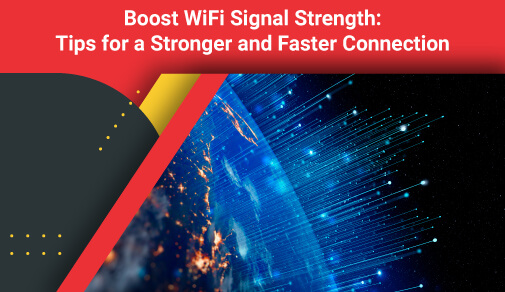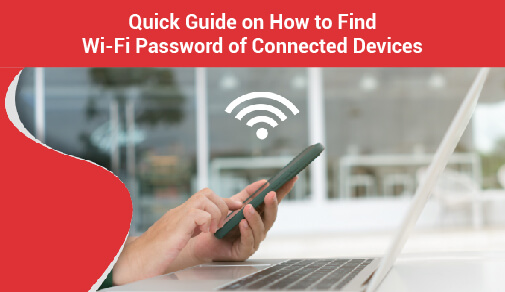Boost wi-fi strength
-
0
-
-
9 minutes

At present, businesses heavily rely on the Internet for communication, office work, and to enhance productivity. Boosting Wi-Fi speed ensures fast and stable internet connectivity, allowing users to browse extensively, use more data, attend video conferences, and download files quickly- all of which are indispensable to the contemporary digital age.
However, weak Wi-Fi signals can lead to many common challenges and frustrate users. One of the primary problems is irregular or dropped connections, where the Wi-Fi signal fluctuates or completely disconnects, disrupting online activities such as video conferences, downloads, streaming, and office projects.
Signal dead zones are also a consistent issue, where certain areas lack Wi-Fi coverage, creating limitations within offices. These challenges highlight the significance of Wi-Fi coverage improvement to ensure a reliable internet connection.
This article will navigate the world of Wi-Fi signals and equip the tools to boost Wi-Fi signals. It will also explore how to improve Wi-Fi strength and enjoy better connectivity.
Understanding Wi-Fi Signals and Factors Affecting Strength
Wi-Fi signals operate on specific radio frequencies within the electromagnetic spectrum, typically 2.4GHz or 5GHz. These signals propagate through the air as electromagnetic waves carry data packets between devices and routers.
When it comes to boosting Wi-Fi signals, it follows the principle of radio wave transmission, where they travel in a straight line until they encounter an obstruction or are absorbed by objects.
Therefore, Wi-Fi strength and quality diminish as it travels away from the router, reducing signal coverage. Also, physical obstructions like walls or furniture and interference from other devices can affect the propagation of Wi-Fi signals, leading to variations in signal strength and potential degradation of the connection.
Identifying reasons for weak signals allows users to troubleshoot unwanted interference and make informed decisions about optimising their network setup. By taking proactive measures to increase Wi-Fi range, users can enhance their internet experience, ensure reliable connectivity, and minimise slow speed or dropped connection.
Optimising Router Placement to Improve Internet Speed At Home
The placement of a router plays a crucial role in Wi-Fi coverage improvement and strength. Strategic placement ensures the signal reaches every corner of the home or office. It minimises dead zones and signal degradation. By positioning the router in an optimal location, users can enhance the performance and reliability of the Wi-Fi network.
Different locations require different router placement strategies. The placement of a router in a central location is recommended for single-story residences to increase Wi-Fi range. Positioning the router on the upper floor in a multi-story building can provide better signal propagation to both feet.
Also, users should avoid the placement of routers near a window because if devices outside the home cannot pick up the connection, the router will work efficiently.
Tips for Minimising Signal Interference and Maximising Coverage
Reduce Interference From Other Devices
Keep the router away from appliances or electronics that emit wireless signals, such as cordless phones, baby monitors, or microwave ovens. These devices use the most common wireless technology, 802.11 g (wireless G), which works at a frequency of 2.4 GHz, interfering with the connection between the user's device and router.
Try a Less Crowded Channel
Suppose many people are using the same Wi-Fi channel in an area. In that case, it can lead to an unreliable internet connection. To solve this issue, users can utilise helpful Wi-Fi scanning tools like inSSIDer by Meta Greek. This tool assists in identifying the least congested channel available for connection.
For 2.4 GHz wireless routers, connecting to one of the three non-overlapping channels 1, 6, and 11 is imperative.
People using a 5 GHz router are less likely to face crowded channels and meet slow internet connectivity. It increases Wi-Fi range and improves Wi-Fi strength.
Extender and Antennas
A range extender can be a valuable solution if users cannot be within the recommended range of 50 to 100 feet from the router due to distance or physical obstruction. It rebroadcasts the router's Wi-Fi signal to reach a large area of your home or office, extending the coverage.
Another option is to add more antennas to the router. By strategically placing multiple antennas at different angles, such as 45°, 60°, and 35°, individuals can create a blanket of Wi-Fi coverage and improve internet speed at home or office.
Utilising Powerline Adapters and Wi-Fi Signal Boosters
Power Line Adapters
Powerline adapters provide an innovative solution for Wi-Fi coverage improvement by utilising the electrical cabling in the home or office. They allow the transmission of data signals through the electrical circuit, effectively creating additional access points for Wi-Fi connectivity.
Users can exchange the Wi-Fi signal to areas with less Wi-Fi coverage by plugging the adaptor into an electrical outlet near the router. The recommended distance for powerline adaptors is 200 metres at maximum.
Wi-Fi Signal Boosters
Wi-Fi signal boosters are also known as range extenders or repeaters. They are designed to amplify and boost Wi-Fi signals. They capture the existing Wi-Fi signal from the router and transmit it to areas where the signal strength is weak.
Wi-Fi signal boosters can benefit large areas or environments with physical obstructions. They boost Wi-Fi reception and reduce dead zones to improve Wi-Fi strength.
Selecting Powerline Adapters and Wi-Fi Signal Boosters
While selecting powerline adapters and Wi-Fi signal boosters, it is very crucial to consider factors such as compatibility with your existing Wi-Fi system, transmission speed, coverage range, security, support, warranty, etc.
Additionally, installation guidelines provided by the manufacturers should be followed to ensure optimal performance.
It is recommended to place powerline adapters or Wi-Fi signal boosters in locations where they can effectively reach the desired areas without interference from other devices. Regular monitoring of Wi-Fi signal boosters and adjusting the placement of these devices can help fine-tune their performance and improve Wi-Fi strength.
Maximising Wi-Fi Strength for Optimal Performance
Importance of Securing Wi-Fi Signals
According to CloudNine data, 81% of successful hacking attempts involve weak or easily guessable passwords.
Securing a boost Wi-Fi signal is vital to prevent unauthorised access and protect sensitive data. By securing a Wi-Fi signal, users can stop unwanted access, prevent data interception and malicious activities.
This protects privacy and also ensures optimal performance by preventing band with theft and network conditions caused by unauthorised devices.
Promote the Best Practices for Wi-Fi Network Security
Implementing best practices to boost Wi-Fi signal security significantly enhances protection. Passwords and encryption protocols play a crucial role in protecting Wi-Fi signals.
Users should make a password at least 12 characters long, including a mix of uppercase and lowercase letters, numbers, and special characters. They should separate their private network from the guest network.
Additionally, enabling WPA2 or WPA3 encryption protocols adds an extra layer of security by encrypting data transmission. Regularly updating the router firmware and enabling automatic security patches help address vulnerabilities and protect against emerging threats.
Common Reasons for Disruption of the Internet
Modem or Gateway Needs a Restart
When encountering internet issues, one of the first troubleshooting steps to try is restarting the modem and router. This practical solution can resolve the problem and refresh the network connection and proper functionality. It also improves internet speed at home and office.
Follow the mentioned steps to restart:
Step 1: The user should unplug the power cable from the back of the equipment.
Step 2: Wait for about 60 seconds, then plug the power cable back in.
Step 3: Wait for the rebooting of the equipment.
Update Your Device
Computers and devices must stay updated to provide smooth functionality in this rapidly evolving technological landscape. However, it's common to procrastinate on updates until an issue arises. Instead of investing valuable time in troubleshooting, it is advisable to prioritise completing any necessary updates.
By staying proactive and keeping systems up to date, users can avoid potential problems and ensure that their devices continue to work seamlessly in the fast-paced world of modern technology.
Auto Switching Between Two Wi-Fi Networks
Sometimes, the device may lose its Wi-Fi signal automatically due to switching between previously connected networks. This behaviour typically occurs when the Wi-Fi signals are weak, and the device attempts to find a more robust connection automatically. To address this issue, consider disabling any auto-joining or auto-switching functions related to Wi-Fi on affected devices.
Reset Computer's Network Setting
Disconnection issues and other persistent glitches can be resolved by giving computers a fresh networking start. However, it's important to note that this action erases all network settings, requiring you to reinstall networking software like antiviruses and VPNs (Virtual Private Network) and reconnect to your home network. Before proceeding, ensure you have all the necessary login credentials.
To reset network settings on Windows 10:
Step 1: Access the settings menu
Step 2: Click Network and internet
Step 3: Select network reset
Step 4: Follow the on-screen instructions
Step 5: Restart the devices
Future Technologies and Trends in Wi-Fi Signal Boosting
As technology continues to advance, there are several emerging technologies and trends on the horizon that hold the potential to boost Wi-Fi signal strength and optimise connectivity.
Explore these promising technologies to boost Wi-Fi reception:
Beamforming Technology
Beamforming lets routers focus Wi-Fi signals directly toward connected devices, increasing signal strength and coverage.
Mesh Networking
Mesh networks utilise multiple access points to create a seamless Wi-Fi network, eliminating dead zones and ensuring consistent coverage throughout large areas.
Multi-User MIMO (MU-MIMO)
MU-MIMO (Multi-User Multi Input Multi Output) technology allows routers to communicate with multiple devices simultaneously, improving overall network capacity and reducing congestion.
Let's look at some emerging trends to boost Wi-Fi reception:
Wi-Fi 6 and Beyond
The introduction of Wi-Fi 6 (802.11ax) brings higher data transfer rates, improved performance in crowded environments, and reduced latency. The future of Wi-Fi, such as Wi-Fi 7, is expected to push the boundaries even further.
Internet of Things (IoT) Integration
With the proliferation of IoT devices, Wi-Fi signal optimisation will be essential to handle the increasing number of connected devices seamlessly.
Smart Antennas and Adaptive Routing
These technologies aim to dynamically adjust antenna configurations and optimise routing paths to maximise signal strength and minimise interference.
Benefits and Challenges of Upcoming Wi-Fi Technologies
Benefits
Future Wi-Fi signal booster technologies promise faster speeds, better coverage, reduced latency, and enhanced network capacity.
They will also enable the seamless integration of emerging technologies like virtual reality, augmented reality, and smart home devices.
Challenges
The adoption of new Wi-Fi technologies may require infrastructure upgrades and compatibility with existing devices. Additionally, ensuring security and addressing potential interference issues will be crucial.
Final Words
In today's digital age, a strong Wi-Fi connection has become the backbone of online lives. By following the strategies and tips outlined in this article, users can significantly boost Wi-Fi signal and enhance their internet experience.
From optimising router placement and selecting the proper Wi-Fi channels to utilise Wi-Fi signal boosters and keeping equipment up to date, these steps will help overcome common barriers that weaken the signal.
Remember, a Wi-Fi signal booster is not just a luxury but a necessity, enabling seamless streaming, smooth online gaming, efficient remote work, and much more.
By investing time and effort into optimising the Wi-Fi setup, individuals can unlock the internet's full potential and enjoy uninterrupted access to the digital world.
If you're seeking a reliable, high-speed, boost Wi-Fi signal, look no further than
ACT Fibernet
.
As a leading provider in the industry, ACT Fibernet offers lightning-fast internet and a range of flexible broadband plans to suit your needs. Our cutting-edge technology and exceptional customer service ensure a seamless online experience for the users.







